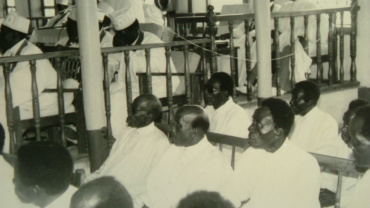In the heart of Ayetoro, where the sound of waves mingled with the rhythm of drums, one of the most striking sights of the 1950s was the ceremonial gathering of the Apostles in their white garments. These gatherings were more than religious services — they were living expressions of the community’s identity, unity, and spiritual vision. To see hundreds dressed in white, assembled beneath the open sky or within the community hall, was to witness the soul of the Happy City.
From the very beginning, the Holy Apostles’ Community embraced the symbolism of the white robe. White stood for purity, equality, and dedication to God. When men, women, and children wore it together, the divisions of class and wealth were erased. In white, fishermen stood alongside traders, elders beside youths, mothers beside daughters — all joined in one spirit. To outsiders, it was unusual; to the Apostles, it was the visible sign of their covenant.
Archival photographs from the 1950s capture the solemn beauty of these occasions. Long rows of men and women, clad in white, filled the hall or spread across the sandy shore. Some stood with heads bowed, others lifted hands to heaven as hymns rang out in harmony. Oral testimonies describe how the ceremonies often began with processions: elders leading with staffs of authority, drummers marking the rhythm, while women sang praises in call-and-response. The sea breeze carried their voices far across the lagoon, so that even those not present felt included.
These gatherings were times of worship, but also of decision-making and teaching. The Ogeloyinbo, Oba Ethiopia O. Peter, often presided, reminding the congregation of the values that defined Ayetoro: honesty, hard work, and mutual care. Sermons stressed that faith was not separate from daily life — it guided fishing, trade, education, and governance. In this way, the ceremonies were both spiritual encounters and moments of civic renewal, reinforcing the principles that held the community together.
For children, the gatherings were unforgettable. They recall sitting quietly on benches, mesmerised by the music and the sea of white robes surrounding them. For adults, they were reminders of shared destiny, binding the community in covenant before God. As one elder later remarked, “When we wore white, we remembered that none of us was greater than the other. We were one family, walking in light.”
Visitors from Lagos and abroad often marvelled at these ceremonies. Some likened them to the early church, when believers gathered with nothing but faith and song. Others saw them as a unique African expression of Christianity, blending biblical tradition with Yoruba rhythm and Ilaje resilience. Whatever the interpretation, the impact was undeniable: the sight of the Apostles in white became the defining image of Ayetoro.

Though time and erosion have changed the physical landscape, the memory of those gatherings endures. The white garments, the hymns, the unity — they remain etched in collective memory as moments when the community touched the sacred. To remember them is to recall the heart of Ayetoro’s promise: that faith and fellowship can build a city of hope.




